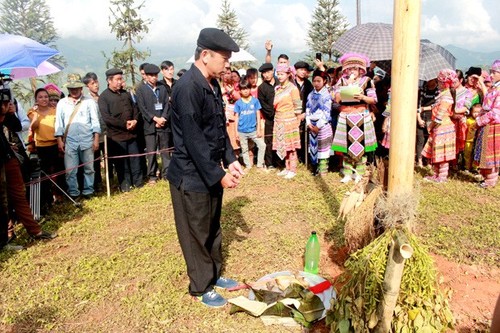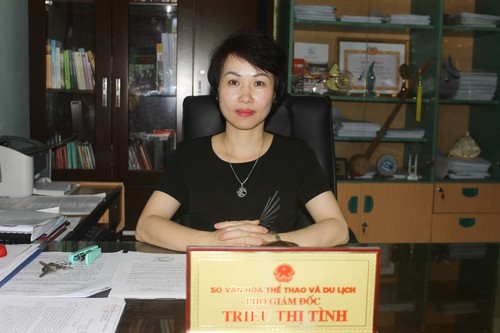 The Gau Tao Festival of the Mong Nam Dich commune, Hoang Su Phi district, Ha Giang province. (photo: bvhttdl.gov.vn) The Gau Tao Festival of the Mong Nam Dich commune, Hoang Su Phi district, Ha Giang province. (photo: bvhttdl.gov.vn) |
Ha Giang has 20 folk festivals reflecting customs and practices of local ethic minorities. The Mong celebrate the Gau Tao festival to pray for peace, prosperity, and good luck.The Nung and Pu Peo worship the Forest Deity.
The Dao organize the Cap Sac ritual for maturity men, while the Pa Then are famous for the Fire Jump festival. The Lo Lo uphold the ancestral worship. The La Chi celebrate a New Rice ritual. The Tay respect the Long Tong, going to the field festival.
Festivals and ceremonies are organized around the year. They include worship and festive activities, including singing, dancing, and folk games. Local ethnic groups have preserved their own languages, literature, folk arts, costumes, working tools, and musical instruments.
 Trieu Thi Tinh, Deputy Director of the Ha Giang provincial Department of Culture, Sports, and Tourism. Trieu Thi Tinh, Deputy Director of the Ha Giang provincial Department of Culture, Sports, and Tourism. |
Trieu Thi Tinh, Deputy Director of the Ha Giang provincial Department of Culture, Sports, and Tourism, said, “Ha Giang has implemented many programs to preserve ethnic culture and heritage. We have restored the Fire Jump festival, Cap Sac and Ban Vuong ceremonies of the Dao, the Forest Deity worship of the Bo Y and Nung, and Crop worship of the Lo Lo."
"We have also promoted traditional crafts such as brocade and flax weaving of the Mong and Dao. We contributed ideas to a resolution to protect cultural values of groups living in the Dong Van Karst Plateau Geopark in combination with tourism development by 2025 and a vision to 2030,” she said.
Quang Binh district has organized vocational and handicraft training courses for young people, such as weaving silk and brocade. Artisans have taught folk singing, dancing, and musical instruments.
Nguyen Trung Dung, Deputy Head of the district’s Culture and Information Office, said the local administration has introduced a plan on ethnic culture preservation and promotion in association with tourism development for the next 10 years.
“We have approved projects to promote typical cultural characteristics of the Pa Then and the Mong toward 2030. Ha Giang province’s Cultural Preservation Project has selected Chi hamlet to pilot activities. We have conducted a survey and signed an agreement with households involved in the project,” Dung said.
Ha Giang province aims to combine cultural preservation and sustainable tourist development. Festivals and customs of ethnic groups have been widely introduced to people inside and outside the country. Community tourism has helped improve people’s lives and motivate cultural preservation efforts.
Trieu Thi Tinh, Deputy Director of the Ha Giang provincial Department of Culture, Sports, and Tourism, said that Ha Giang has set up 16 cultural tourism villages.
“We organize regular events, collaborate with organizations to promote the culture of ethnic groups on digital platform to attract visitors. When the COVID-19 pandemic is contained, Vietnamese and foreign tourists can come to Ha Giang to join these activities. We have contributed ideas to the provincial authority to offer safe, friendly, and attractive services to visitors,” Tinh said.
Ha Giang province has regularly invested in improving sites, scenic spots, and infrastructure, while organizing training classes for cultural and tourism officials.